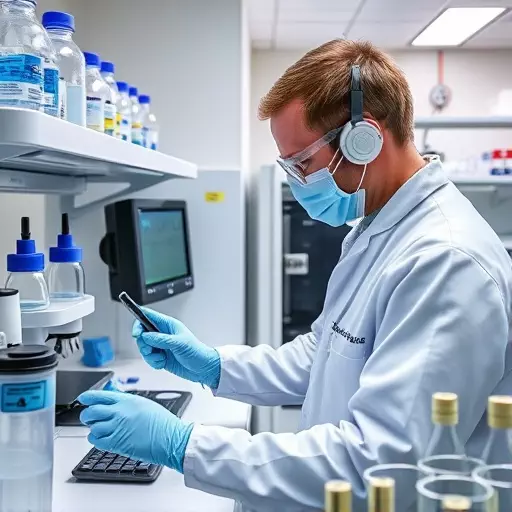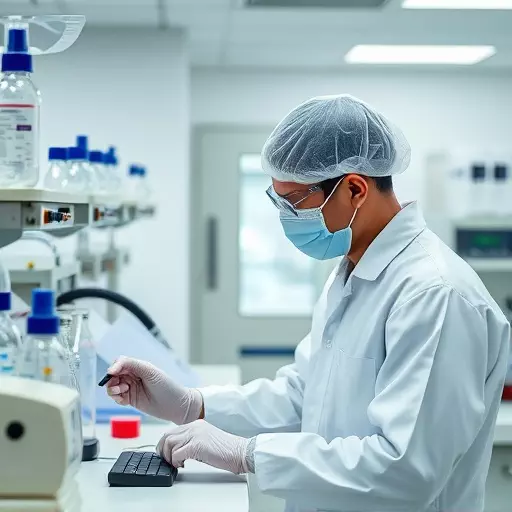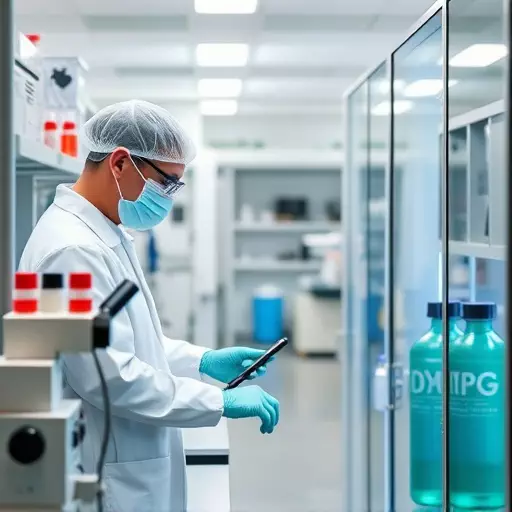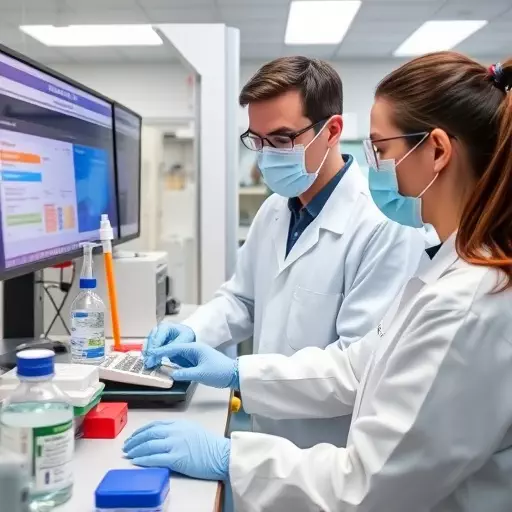In Gary-Lake Station's demanding lab environment, sample integrity is non-negotiable. Key strategies include designing intuitive lab interfaces to boost technician productivity and minimize errors, implementing predictive maintenance for equipment to extend lifespans and reduce downtime, and establishing Standard Operating Procedures (SOPs) with rigorous Quality Assurance (QA) checks for seamless sample transportation. Comprehensive training empowers technicians to handle samples accurately, while leveraging technology like sensors and data analytics ensures consistent performance throughout the lab work process, ultimately driving innovation and reliable results.
Maintaining sample integrity is paramount in ensuring accurate lab results, especially in diverse environments like Gary-Lake Station. This article explores best practices to safeguard samples during transportation, covering critical aspects from designing intuitive lab interfaces to leveraging technology for real-time monitoring. We delve into the importance of predictive maintenance, standard operating procedures (SOPs), quality assurance checks, and comprehensive training to enhance technician proficiency. By implementing these strategies, labs can ensure the reliability of their work in Gary-Lake Station and beyond, aligning with the evolving demands of modern science.
- Understanding the Importance of Sample Integrity: A Cornerstone for Accurate Lab Work in Gary-Lake Station
- Designing User-Friendly Lab Interfaces: Enhancing Efficiency for Technicians
- The Role of Predictive Maintenance in Ensuring Longevity of Lab Equipment
- Establishing Standard Operating Procedures (SOPs) for Seamless Sample Transportation
- Implementing Quality Assurance Checks at Critical Stages of the Transportation Process
- Training and Education: Empowering Technicians with Knowledge for Integrity Maintenance
- Leveraging Technology for Real-Time Monitoring and Tracking of Samples
Understanding the Importance of Sample Integrity: A Cornerstone for Accurate Lab Work in Gary-Lake Station
In the high-stakes world of lab work in Gary-Lake Station, ensuring sample integrity is more than a best practice—it’s a cornerstone for accurate and reliable results. Every step in the transportation process must be meticulously planned and executed to maintain the viability and authenticity of samples, especially given the intricate nature of modern laboratory procedures. From designing user-friendly lab interfaces that streamline technician efficiency to implementing predictive maintenance routines for crucial equipment, prioritizing sample integrity drives the overall quality of research and analysis.
This focus on integrity is pivotal in a bustling lab environment where countless experiments and tests rely on consistent data. By minimizing risks like contamination, degradation, or mishandling, labs can foster an atmosphere conducive to innovation and discovery. In Gary-Lake Station, where diverse scientific disciplines converge, maintaining sample integrity becomes a collaborative effort involving technicians, researchers, and equipment manufacturers alike—all working towards the common goal of preserving the accuracy and reproducibility of lab work.
Designing User-Friendly Lab Interfaces: Enhancing Efficiency for Technicians

Designing user-friendly lab interfaces is a best practice that enhances efficiency for technicians conducting lab work in Gary-Lake Station and similar environments. Streamlined interfaces reduce training time, minimize errors, and improve productivity by providing intuitive access to essential functions and data. Incorporating customizable dashboards, clear instructions, and straightforward navigation allows technicians to focus on accurate sample transportation rather than struggling with complex systems.
Furthermore, implementing predictive maintenance for lab equipment can significantly contribute to longevity in Gary-Lake Station. By leveraging advanced sensors and data analytics, labs can anticipate potential issues before they occur, reducing unexpected downtime and costly repairs. This proactive approach ensures continuous operations and enhances the reliability of sample transportation processes, ultimately maintaining high standards of integrity.
The Role of Predictive Maintenance in Ensuring Longevity of Lab Equipment

In today’s digital era, implementing predictive maintenance is pivotal for safeguarding the longevity of lab equipment used in Gary-Lake Station lab work. By leveraging advanced technologies like sensors and data analytics, labs can anticipate potential failures before they occur. This proactive approach allows technicians to schedule maintenance at optimal times, minimizing downtime and maximizing efficiency. Moreover, it helps in designing user-friendly lab interfaces that streamline workflows, ensuring consistent and reliable results.
Predictive maintenance not only extends the lifespan of critical equipment but also fosters a culture of continuous improvement within the laboratory setting. As data is collected and analyzed, trends emerge, guiding improvements in maintenance protocols and even the design of new lab interfaces. This iterative process ultimately contributes to enhanced technician efficiency and the consistent production of high-quality results in Gary-Lake Station lab work.
Establishing Standard Operating Procedures (SOPs) for Seamless Sample Transportation

Establishing Standard Operating Procedures (SOPs) is a cornerstone in maintaining integrity during sample transportation at facilities like Gary-Lake Station. These detailed, step-by-step guides ensure consistent and accurate handling of samples from the moment they’re collected until their final destination. By designing user-friendly lab interfaces that streamline workflows, technicians can efficiently follow SOPs without unnecessary delays or errors. This approach is particularly crucial in environments like Gary-Lake Station where lab work demands precision and timely turnaround.
Implementing predictive maintenance alongside well-defined SOPs further enhances equipment longevity and sample integrity. Regular monitoring and data analysis enable anticipatory action on potential issues, minimizing unexpected breakdowns that could disrupt sample transportation. In essence, a combination of robust SOPs and predictive maintenance creates a seamless, reliable system for managing lab work in Gary-Lake Station, ensuring the integrity of every sample transported.
Implementing Quality Assurance Checks at Critical Stages of the Transportation Process

In ensuring the integrity of samples during transportation from the Gary-Lake Station, implementing robust Quality Assurance (QA) checks at critical stages is paramount. These checks should encompass a comprehensive review at each major step, beginning from receipt and preparation in the lab, through packaging, up to final dispatch. By integrating user-friendly lab interfaces designed for technician efficiency, the process becomes streamlined, minimizing human error. This not only enhances the accuracy of sample handling but also contributes to the overall reliability of lab work in Gary-Lake Station.
Predictive maintenance plays a crucial role in preserving the longevity of lab equipment used in this transportation process. By leveraging technological advancements, it is possible to monitor equipment performance and predict potential failures before they occur. This proactive approach not only reduces unexpected downtime but also ensures that samples are handled with consistent quality throughout their journey, maintaining the integrity and reliability of the data collected during lab work in Gary-Lake Station.
Training and Education: Empowering Technicians with Knowledge for Integrity Maintenance

In the realm of lab work in Gary-Lake Station and beyond, maintaining integrity throughout sample transportation is paramount to ensuring accurate and reliable results. Training and education play a crucial role in empowering technicians with the knowledge needed for this delicate task. By providing comprehensive training, organizations can instill a deep understanding of best practices in their workforce, fostering a culture of precision and care. This includes educating technicians on designing user-friendly lab interfaces that streamline workflows, enhancing efficiency while minimizing errors during sample handling.
Furthermore, implementing predictive maintenance strategies for lab equipment is essential to longevity. By staying proactive rather than reactive, labs can avoid costly breakdowns and minimize downtime. Predictive maintenance techniques leverage data analytics and machine learning to anticipate equipment failures before they occur, ensuring smooth operations and uninterrupted service. This holistic approach to integrity maintenance not only benefits the accuracy of lab work but also enhances the overall productivity and sustainability of Gary-Lake Station’s scientific endeavors.
Leveraging Technology for Real-Time Monitoring and Tracking of Samples

In the realm of lab work in Gary-Lake Station, leveraging technology is paramount for maintaining sample integrity during transportation. User-friendly interfaces designed with efficiency in mind allow technicians to seamlessly manage and track samples in real-time. These digital tools not only simplify the documentation process but also enable quick adjustments to transportation protocols should any deviations occur. By implementing these user-friendly lab interfaces, the risk of human error is minimized, ensuring that each step of the sample transport process is accurately recorded and monitored.
Moreover, predictive maintenance plays a crucial role in extending the lifespan of lab equipment used for transportation. Through advanced algorithms and sensors, labs can anticipate potential failures or maintenance needs before they occur. This proactive approach not only saves time and resources but also guarantees consistent performance during sample collection and delivery. In light of these innovations, implementing predictive maintenance for lab equipment is a game-changer in maintaining integrity throughout the entire transportation process, ultimately enhancing the reliability and accuracy of lab work in Gary-Lake Station.
